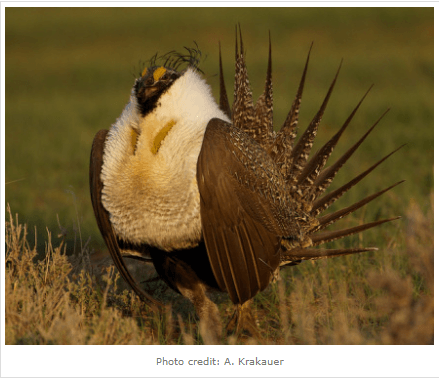(January 14, 2015, The Auk: Ornithological Advances)—Songs and calls aren’t the only sounds birds make. Some, such as the Greater Sage-grouse (Centrocercus urophasianus), also produce mechanical sounds called “sonations” with their feet, feathers, or bills. But do the mechanical “swishes” of male sage-grouse affect their mating success? In a new open-access study published in The Auk: Ornithological Advances, Rebecca Koch of Auburn University and Alan Krakauer and Gail Patricelli of the University of California-Davis reveal that male sage-grouse are most attractive to females when they increase the intensity of their swishing display as females get closer.
For two years, Koch and her colleagues observed and recorded the behavior of male sage-grouse on a breeding ground or “lek” in Wyoming, using microphones and video cameras to record the sounds they made and to keep track of which males got the most mating action. While the effects of the males’ vocalizations on their success had already been studied, the effect of their mechanical swishing noises had not, so the researchers identified which swishes on the sound recordings were produced by which individual birds in the videos and then analyzed whether there was any relationship between the acoustic qualities of the swishes and how many copulations each male achieved.
They found that males definitely varied in the length and frequency range of their swish displays, but these variations did not appear to have any direct effect on their mating success–it was all in the timing. The males that did the best were those who adjusted their displays as the social environment of the lek changed, upping the frequency ranges of their swishes when females got closer. This closely aligns with the results of a previously published study that found that successful males displayed at a higher rate when females approached, and the most successful were able to increase their display rate without any trade-off in display quality. The take-away message is that males track nearby females to display most intensely when it really matters.
“As researchers interested in sexual selection, it is easy for us to assume that all traits involved in mating displays are used as criteria in female mate choice,” explains Ms. Koch. “However, in sage-grouse, it appears that the tactical adjustment of displays as females approach is more important in soliciting mates than is display quality in itself.” Dr. Kimberly Bostwick of Cornell University, an editor at The Auk who studies sonation in manakins and was not involved in conducting the study, adds that this study “places a foundational stone for future work comparing sonations to vocal signals.” The functions of mechanical sounds in courtship are just beginning to be understood, and this paper is an important first step.

“Investigating female mate choice for mechanical sounds in the male Greater Sage-Grouse” is an open-access article that can be viewed at http://www.aoucospubs.org/doi/full/10.1642/AUK-14-63.1. Contact: Rebecca Koch, rek0005@auburn.edu.
About the journal: The Auk: Ornithological Advances is a peer-reviewed, international journal of ornithology. The journal has been the official publication of the American Ornithologists’ Union since 1884. In 2009, The Auk was honored as one of the 100 most influential journals of biology and medicine over the past 100 years, and currently holds the top impact factor among ornithological journals.